Frustrated with Prior Authorizations? There's a Better Way.
Prior authorizations delaying patient care and consuming your staff's time? This list offers solutions. Discover seven leading prior authorization software options to simplify this complex process. We'll compare features, pros, and cons of tools like Simbie AI, Waystar, Allscripts, CoverMyMeds, Surescripts, Trizetto, and MedEvolve, helping you choose the best prior authorization software for your practice, regardless of size. Streamline your workflow and reclaim valuable time with the right software.
1. Simbie AI
Struggling with the administrative burden of prior authorizations? Simbie AI offers a compelling solution. This voice-based artificial intelligence platform is specifically designed for healthcare practices looking to automate routine tasks, including prior authorizations, and improve patient engagement. Developed by medical researchers and physicians, Simbie AI aims to alleviate the strain on healthcare staff by handling numerous administrative functions with clinically-trained AI agents. This allows your team to dedicate more time to direct patient care, ultimately leading to improved patient outcomes and satisfaction. For practices drowning in paperwork and phone calls, Simbie AI presents a potential lifeline, offering a route to streamlined workflows and enhanced efficiency. Its inclusion in this list is warranted by its comprehensive approach to automating critical administrative tasks, particularly the often-complex prior authorization process.
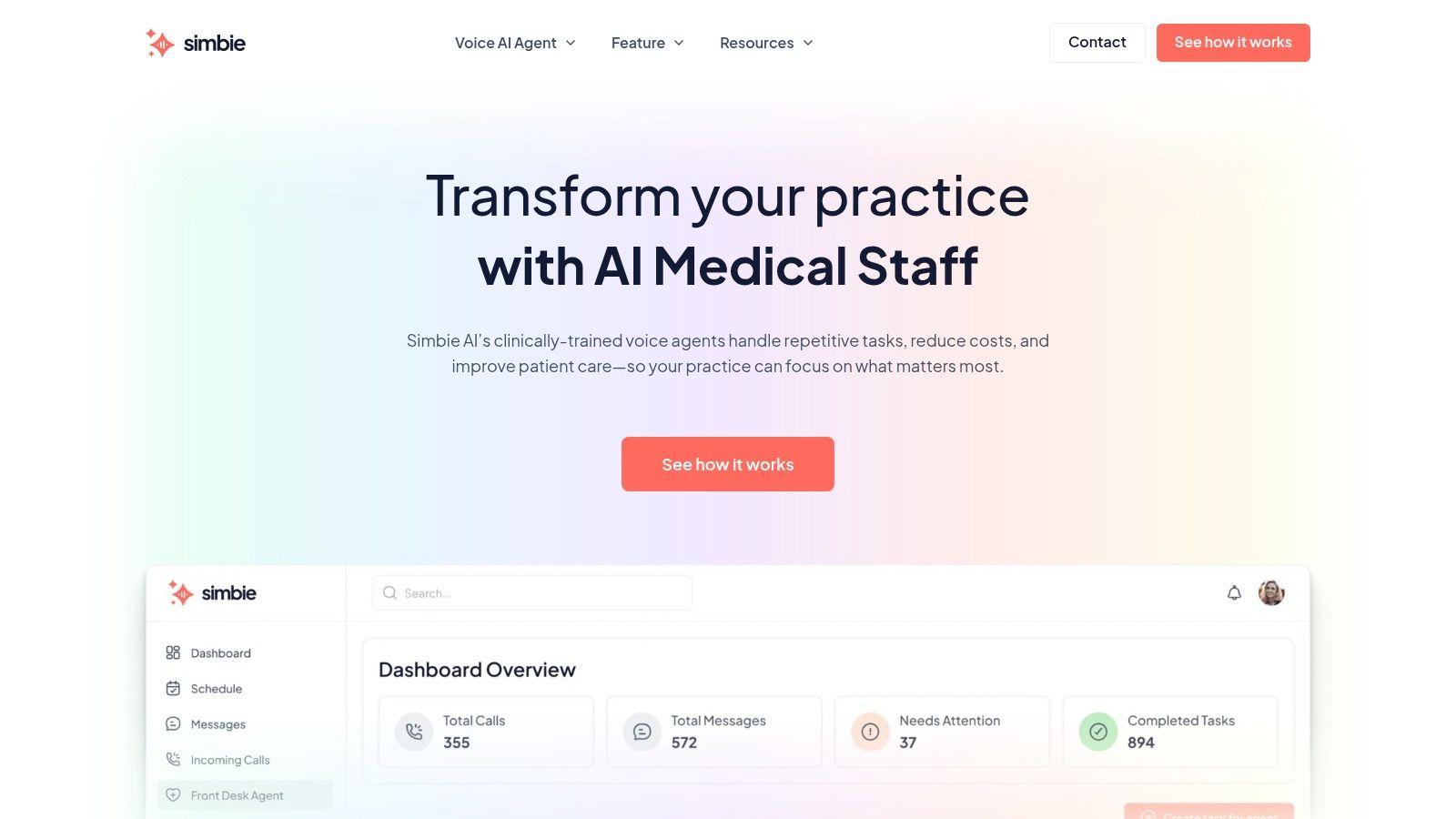
One of Simbie AI’s key strengths is its ability to manage prior authorizations seamlessly. The AI agents are trained on clinical protocols and can navigate the complexities of insurance requirements, saving your staff countless hours of manual work. Instead of chasing down approvals and filling out endless forms, your staff can focus on what they do best: providing patient care. This automation translates directly into significant cost savings by reducing administrative overhead. Simbie AI boasts a potential reduction in administrative costs of up to 60%, a compelling figure for any practice seeking to optimize its financial performance. Beyond prior authorizations, Simbie AI handles a range of tasks, including patient intake, appointment scheduling, prescription refills, and even personalized patient education. This comprehensive approach makes it a valuable tool for practices of all sizes, from small clinics to large healthcare systems.
Simbie AI also addresses a major pain point for many healthcare providers: 24/7 availability. The platform manages calls around the clock, eliminating missed calls and hold times. This enhanced accessibility leads to improved patient satisfaction and access, especially for patients who may have difficulty reaching the office during traditional business hours. Furthermore, the system integrates directly with existing Electronic Medical Record (EMR) systems. This seamless integration ensures that all patient interactions, including prior authorization requests and approvals, are automatically documented and incorporated into the patient's electronic chart. This eliminates manual data entry, reduces errors, and provides a centralized, readily accessible record of patient information.
While Simbie AI offers a range of benefits, there are a few considerations. Integrating new software into existing workflows always requires some initial setup and training. While Simbie AI strives for seamless integration, practices should anticipate some adjustment time as staff become familiar with the platform. Additionally, while the AI agents are highly trained, complex patient communication scenarios might still require the intervention of human staff. The platform excels at handling routine tasks but may not be able to address every nuanced patient interaction. Pricing information and specific technical requirements are not readily available on the website and would require contacting Simbie AI directly. This lack of readily available information could be a barrier for some practices looking to compare options quickly.
Implementation Tips:
- Dedicated Training: Allocate sufficient time for staff training to ensure smooth adoption and maximize the platform’s potential.
- Workflow Analysis: Before implementation, thoroughly analyze existing workflows to identify areas where Simbie AI can be most effective.
- Gradual Rollout: Consider a phased rollout of the platform's features to allow staff to adapt to the changes gradually.
- Ongoing Evaluation: Regularly assess the platform's performance and identify areas for improvement or further optimization.
Simbie AI represents a significant advancement in prior authorization software, offering a powerful combination of AI-driven automation, 24/7 availability, and seamless EMR integration. While there are some implementation considerations, the potential benefits in terms of cost savings, increased efficiency, and improved patient satisfaction make it a valuable tool for healthcare practices looking to optimize their operations and enhance patient care. For more information, visit the Simbie AI website: https://www.simbie.ai
2. Waystar (formerly Zirmed)
Waystar, formerly known as Zirmed, stands as a leading provider of prior authorization software, offering a comprehensive solution designed to alleviate the administrative burdens associated with this often complex process. For healthcare providers ranging from small practices to large hospital systems, Waystar streamlines the entire prior authorization workflow, from eligibility verification to final approval. This automation allows clinical staff to focus on patient care rather than paperwork, ultimately contributing to improved efficiency and accelerated care delivery.
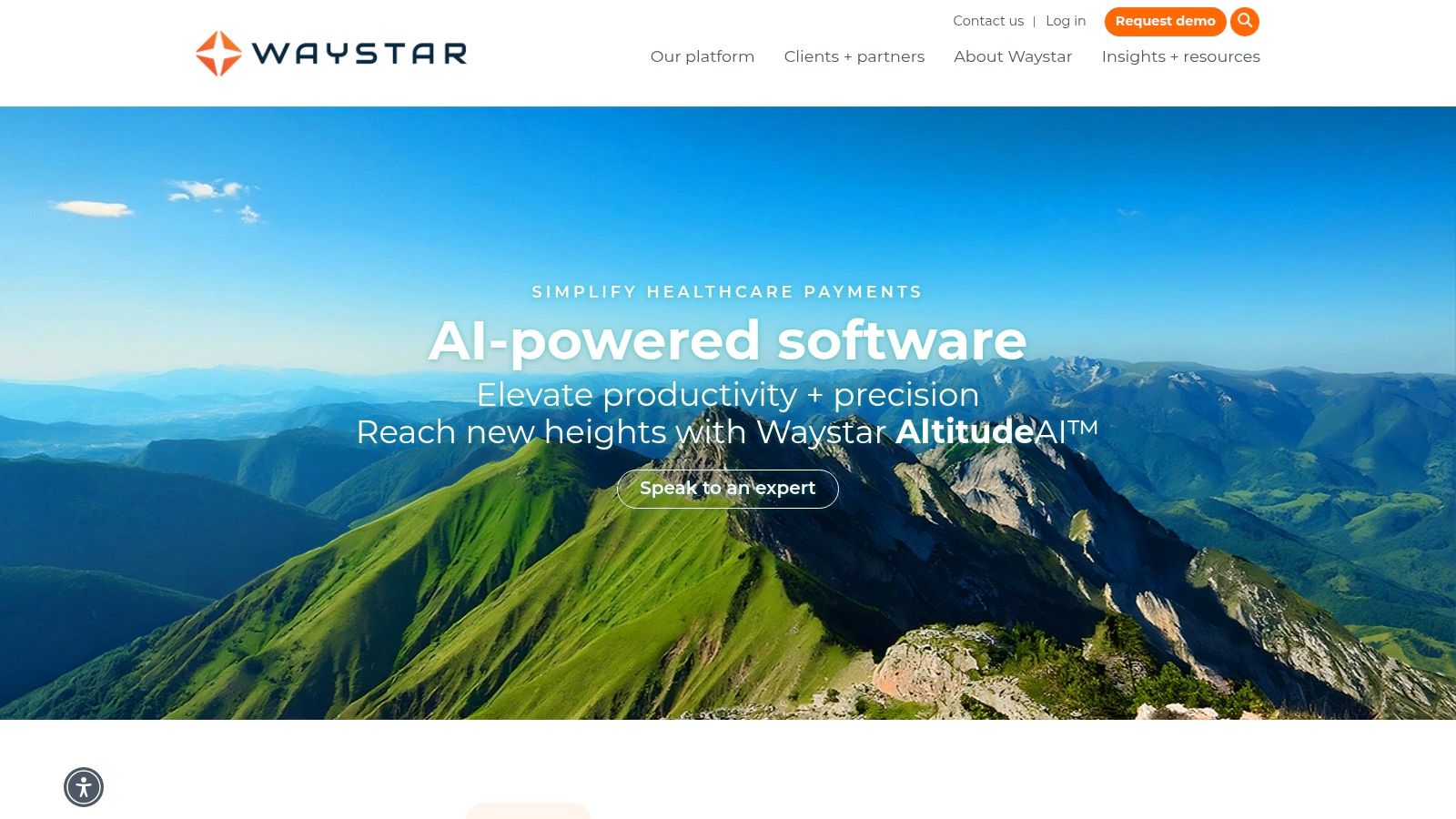
Waystar's prior authorization software distinguishes itself through a suite of robust features designed to address the pain points frequently encountered in the authorization process. Real-time eligibility and benefits verification eliminates guesswork and reduces the likelihood of claim denials due to incorrect patient information. Automated workflow management ensures that authorization requests are routed efficiently and tracked throughout the process. This automation minimizes the risk of delays or lost requests, common occurrences in manual processes. Furthermore, the platform's direct integration with major EHR systems, such as Epic, Cerner, and Allscripts, provides a seamless experience, eliminating the need for duplicate data entry and reducing the risk of errors. Electronic submission and tracking of authorization requests offer real-time visibility into the status of each request, allowing staff to proactively address any potential issues. Automated status updates and notifications keep all stakeholders informed, further optimizing communication and reducing the need for time-consuming follow-up calls.
The benefits of implementing Waystar's prior authorization software are substantial. One of the most significant advantages is the drastic reduction in manual paperwork and administrative time. This efficiency translates to cost savings and allows staff to focus on higher-value tasks. The robust integration capabilities with popular EHR systems minimize disruption to existing workflows and maximize interoperability. Real-time processing significantly improves turnaround times for authorizations, enabling faster patient access to necessary care. Furthermore, Waystar provides a comprehensive reporting and analytics dashboard offering valuable insights into authorization trends, payer performance, and areas for improvement. This data-driven approach allows practices to identify bottlenecks, optimize workflows, and ultimately enhance revenue cycle management.
While Waystar offers numerous advantages, potential users should consider a few factors. The software can be expensive, particularly for smaller practices with limited budgets. Pricing models typically vary based on practice size, transaction volume, and features included. It’s recommended to contact Waystar directly to obtain a customized quote based on specific needs. The initial setup and integration may require technical expertise, although Waystar provides implementation support to assist with this process. Some users have also reported occasional system downtime, which can temporarily disrupt workflows. While Waystar maintains high uptime standards, it's essential to have contingency plans in place should any disruptions occur.
For practices considering implementing Waystar, several tips can streamline the process. First, thoroughly assess your current prior authorization workflow and identify specific pain points. This analysis will help determine which features are most critical for your needs. Next, engage with Waystar's implementation team early in the process to ensure a smooth transition. They can provide guidance on data migration, system configuration, and staff training. Finally, leverage the reporting and analytics dashboard to track key performance indicators and identify areas for ongoing optimization.
Compared to other prior authorization software solutions, Waystar stands out for its comprehensive feature set and robust integrations. While some competitors may offer more specialized solutions focusing on specific specialties or payer types, Waystar's breadth of capabilities makes it a suitable option for diverse healthcare settings. For practices seeking a comprehensive prior authorization solution that streamlines workflows, improves efficiency, and accelerates patient care, Waystar is a strong contender. Its ability to integrate with existing EHR systems, automate tedious tasks, and provide real-time insights makes it a valuable tool for optimizing revenue cycle management and enhancing patient satisfaction. The investment in prior authorization software like Waystar can significantly improve the financial health and operational efficiency of healthcare practices, justifying its inclusion in this list of top solutions. You can explore their offerings further by visiting their website: https://www.waystar.com/
3. Allscripts Prior Authorization
Streamlining the often cumbersome process of prior authorizations is crucial for healthcare providers to ensure timely patient care and maintain a healthy revenue cycle. Allscripts Prior Authorization offers a robust solution integrated within the Allscripts EHR ecosystem, designed to automate and simplify this critical administrative task. This integration allows practices using Allscripts EHR to manage prior authorizations seamlessly within their existing workflow, eliminating the need to switch between different systems. This streamlined approach can significantly reduce administrative overhead, freeing up valuable time for both clinical and administrative staff. For practices already invested in the Allscripts environment, this integrated approach offers a compelling advantage.
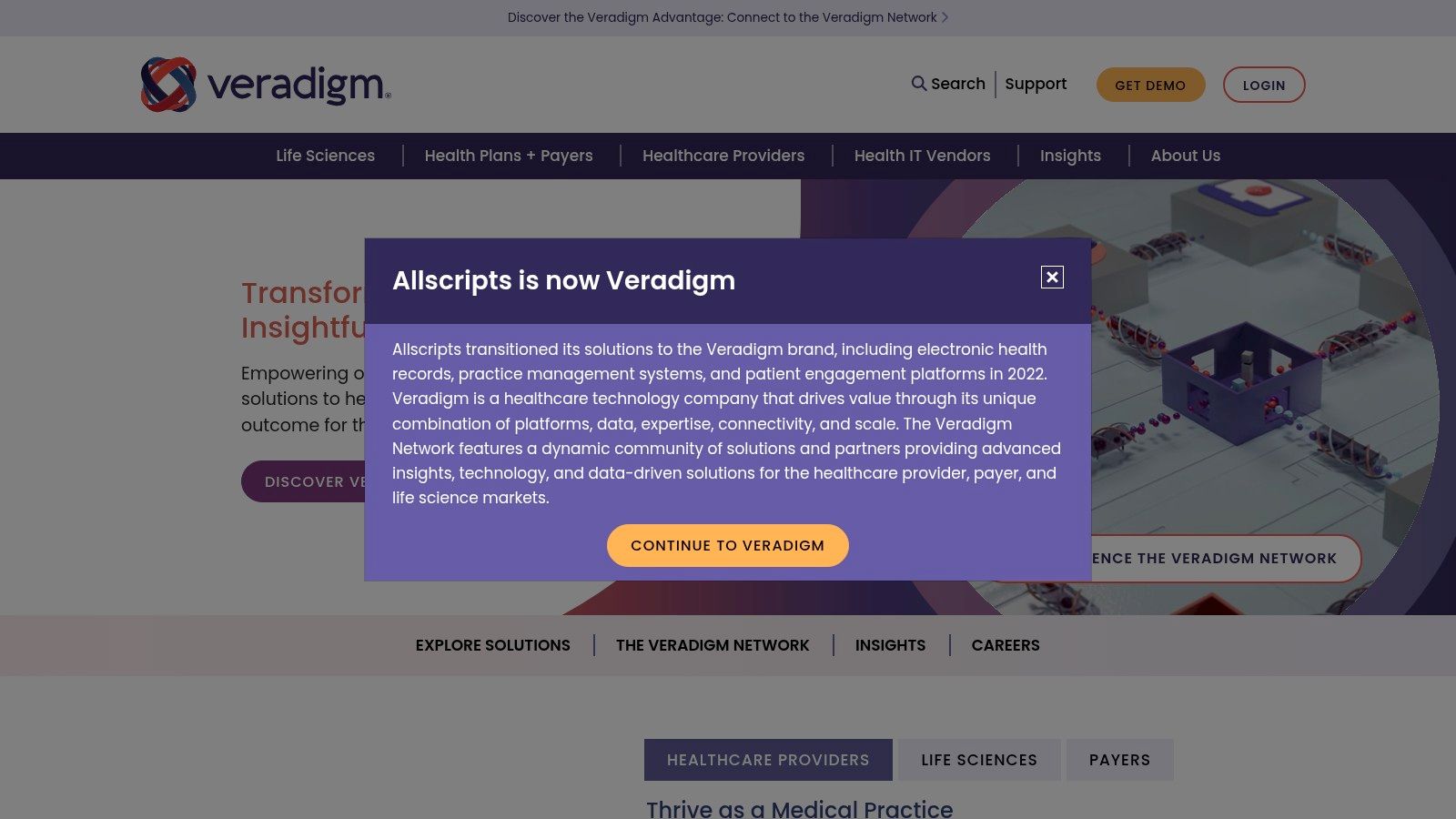
Allscripts Prior Authorization automates the entire prior authorization lifecycle, from initial request generation to tracking approvals and managing denials. The platform leverages electronic data interchange (EDI) to connect directly with payers and clearinghouses, enabling real-time status updates and reducing the reliance on manual phone calls and faxes. This automated workflow translates to faster turnaround times for authorizations, leading to quicker patient access to necessary care and minimizing potential revenue delays. The system also helps to minimize claim denials related to authorization issues, further improving the practice's financial performance.
One of the standout features of Allscripts Prior Authorization is its native integration within the Allscripts EHR ecosystem. This seamless integration means that providers can initiate and manage prior authorizations directly from the patient's chart, eliminating the need for duplicate data entry and minimizing the risk of errors. The platform also offers customizable workflow templates, allowing practices to tailor the authorization process to their specific needs and specialties. For instance, a cardiology practice can configure templates specific to common cardiology procedures, further streamlining the workflow. This level of customization makes the system adaptable to diverse clinical settings.
Real-time status tracking is another valuable feature, providing up-to-the-minute visibility into the progress of each authorization request. This transparency empowers staff to proactively address any potential delays or issues, ensuring that patients receive timely care. Furthermore, the system offers robust reporting capabilities, providing insights into authorization trends and payer performance, which can be used to optimize processes and improve revenue cycle management.
Pros:
- Seamless integration for existing Allscripts users: The platform's native integration minimizes disruption to existing workflows and eliminates the need for separate logins and data entry.
- Reduces time spent on manual authorization processes: Automation streamlines the entire process, freeing up staff time for other critical tasks.
- Built-in compliance with healthcare regulations: The software is designed to adhere to industry standards and regulations, minimizing compliance risks.
- User-friendly interface familiar to Allscripts users: The intuitive interface minimizes the learning curve for existing Allscripts users.
Cons:
- Limited to Allscripts EHR ecosystem: Practices using other EHR systems cannot utilize this solution.
- May require additional licensing fees: While integrated with the Allscripts EHR, specific modules or features might require additional licensing fees. Contact Allscripts directly for detailed pricing information based on your practice's needs.
- Some advanced features require separate modules: Certain functionalities, such as advanced analytics or reporting, might necessitate purchasing separate modules.
Implementation and Setup:
Implementation typically involves working with Allscripts representatives to configure the system and integrate it with existing workflows and payer connections. While specific technical requirements will vary based on the practice's existing infrastructure, generally, a stable internet connection and compatible hardware are necessary. Allscripts provides training and support resources to assist practices during the implementation and ongoing use of the platform.
Comparison with Similar Tools:
While other prior authorization software solutions exist, such as CoverMyMeds and Auth-X, Allscripts Prior Authorization differentiates itself through its tight integration with the Allscripts EHR. This integration offers a significant advantage for existing Allscripts users, simplifying workflows and maximizing efficiency. However, practices not using Allscripts should explore other options better suited to their specific EHR environment.
Website: https://www.allscripts.com/
Allscripts Prior Authorization provides a powerful and efficient solution for managing prior authorizations within the Allscripts EHR environment. Its automated workflows, real-time tracking, and seamless integration can significantly benefit practices seeking to streamline administrative processes, improve revenue cycle management, and ultimately, enhance patient care. However, practices should carefully consider the potential limitations and licensing fees before committing to this solution. Contacting Allscripts directly for a personalized demo and pricing is highly recommended.
4. CoverMyMeds
CoverMyMeds is a widely recognized leader in the prior authorization software space, offering a comprehensive platform designed to simplify the often complex process of obtaining medication approvals. It bridges the communication gap between healthcare providers, pharmacies, and payers, streamlining workflows and reducing administrative burden. This makes it a valuable tool for a range of healthcare professionals, from individual physicians to large hospital systems, seeking to improve efficiency and patient access to necessary medications. CoverMyMeds distinguishes itself with its broad payer network reach and integrations with major Electronic Health Record (EHR) systems. This interoperability is key for practices looking to incorporate prior authorization seamlessly into their existing workflows.
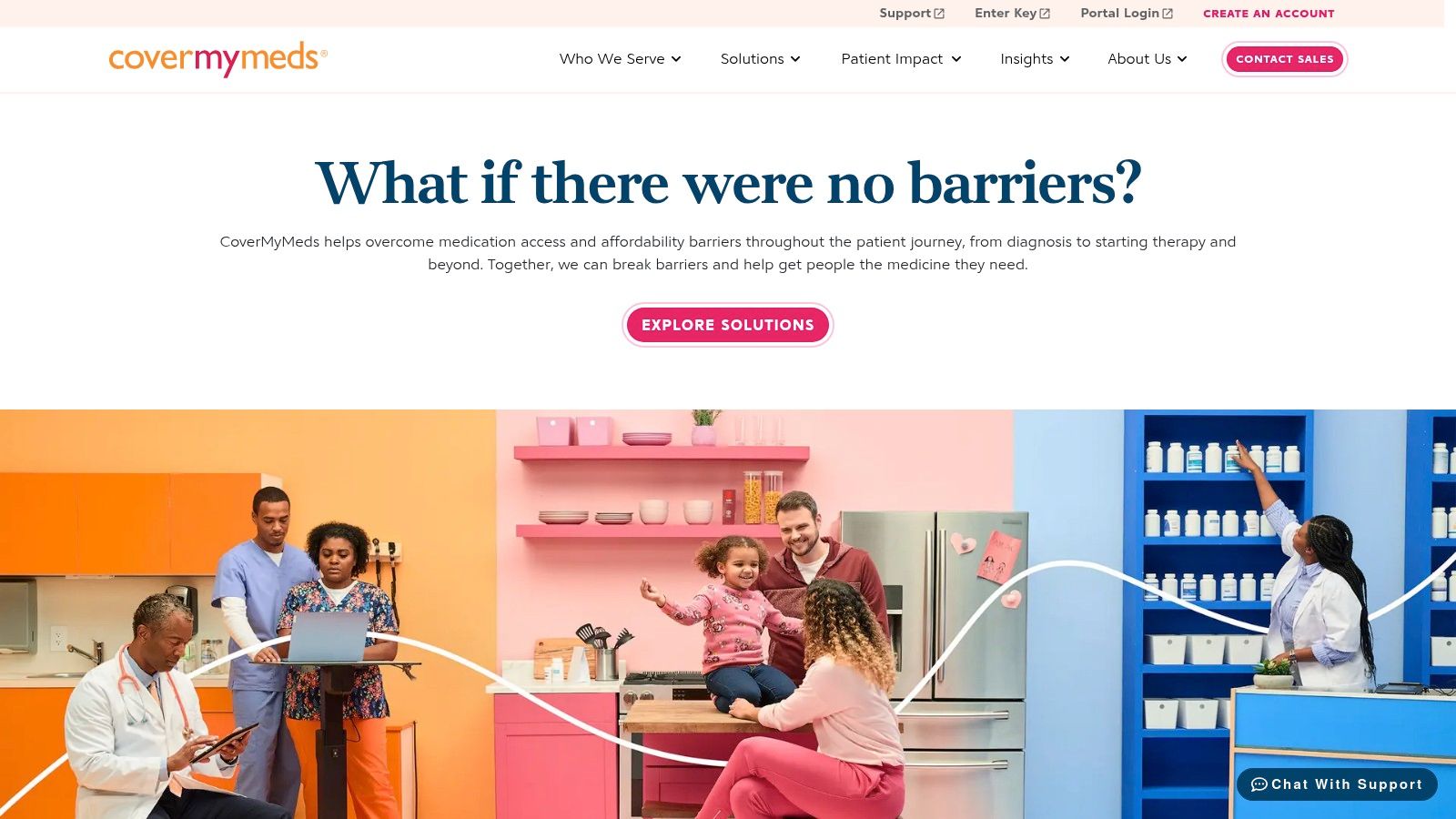
CoverMyMeds offers both prescription and medical prior authorization solutions. This means it can handle approvals for both medications dispensed at a pharmacy and medical procedures requiring pre-approval from insurance. This dual functionality is particularly beneficial for specialists and hospitals who frequently require authorizations for a variety of services and treatments. The platform boasts connections to over 500 health plans, covering a significant portion of insured patients in the United States. This extensive payer network is a major advantage, reducing the need for providers to navigate different payer portals and processes.
A key feature of CoverMyMeds is its integration with popular EHR systems. This integration allows providers to initiate and manage prior authorizations directly within their existing clinical workflows, eliminating the need to switch between different applications. This streamlines the process significantly, saving valuable time and reducing the potential for errors. The platform provides real-time formulary and coverage information, giving providers instant insights into patient-specific benefits and potential out-of-pocket costs. This allows for informed decision-making at the point of care, potentially leading to better patient adherence and outcomes. Additionally, a mobile app is available, providing on-the-go access to prior authorization statuses and updates, enhancing flexibility and responsiveness.
For smaller practices, CoverMyMeds offers a free basic tier, providing access to core prior authorization functionality. This makes it a financially accessible option for practices just starting out with electronic prior authorization or those with limited budgets. Larger practices and health systems requiring more advanced features and integrations can opt for a paid subscription, offering a tiered approach to pricing based on individual needs. While specific pricing details aren't publicly available, prospective users can contact CoverMyMeds directly for a customized quote.
While CoverMyMeds is a powerful tool, it's important to be aware of its potential drawbacks. The interface, while feature-rich, can be complex for new users and may require dedicated training to master. While the company provides excellent customer support and training resources, some initial learning curve should be anticipated. Integrating CoverMyMeds with certain EHR systems may also require technical setup and involvement from IT staff. This is an important consideration for practices with limited internal IT resources.
Compared to other prior authorization software solutions, CoverMyMeds stands out due to its extensive payer network and strong reputation within the pharmacy benefit management space. While other solutions may offer similar features, the breadth of CoverMyMeds' payer coverage and its established presence in the market make it a compelling choice for many practices.
Implementing CoverMyMeds effectively requires a strategic approach. Begin by identifying key staff members who will be using the platform and ensure they receive adequate training. Work with your IT department or a CoverMyMeds representative to configure the software and ensure seamless integration with your EHR system. Establish clear internal workflows for managing prior authorizations, assigning roles and responsibilities to different team members. Regularly review reports and analytics provided by the platform to identify areas for optimization and process improvement.
In conclusion, CoverMyMeds offers a robust and comprehensive prior authorization software solution suitable for a variety of healthcare settings. Its extensive payer network, EHR integrations, and real-time benefit information make it a powerful tool for streamlining medication approvals and improving patient access to care. While some complexities exist with the interface and potential integration challenges, the benefits often outweigh the drawbacks, making CoverMyMeds a worthy contender for practices seeking to optimize their prior authorization processes. For more detailed information and to explore pricing options, visit their website at https://www.covermymeds.com/.
5. Surescripts Real-Time Prescription Benefit
Surescripts Real-Time Prescription Benefit is a leading prior authorization software solution designed to streamline the prescription process and improve patient care. It integrates directly into existing prescriber workflows, offering a comprehensive suite of medication management tools, including formulary lookup, benefit verification, and electronic prior authorization submission. This powerful platform helps healthcare providers make informed prescribing decisions, reduce prescription abandonment rates, and improve medication adherence. This software is a valuable asset for a variety of healthcare settings, from small practices to large health systems, helping to navigate the complexities of prior authorizations for prescription medications.
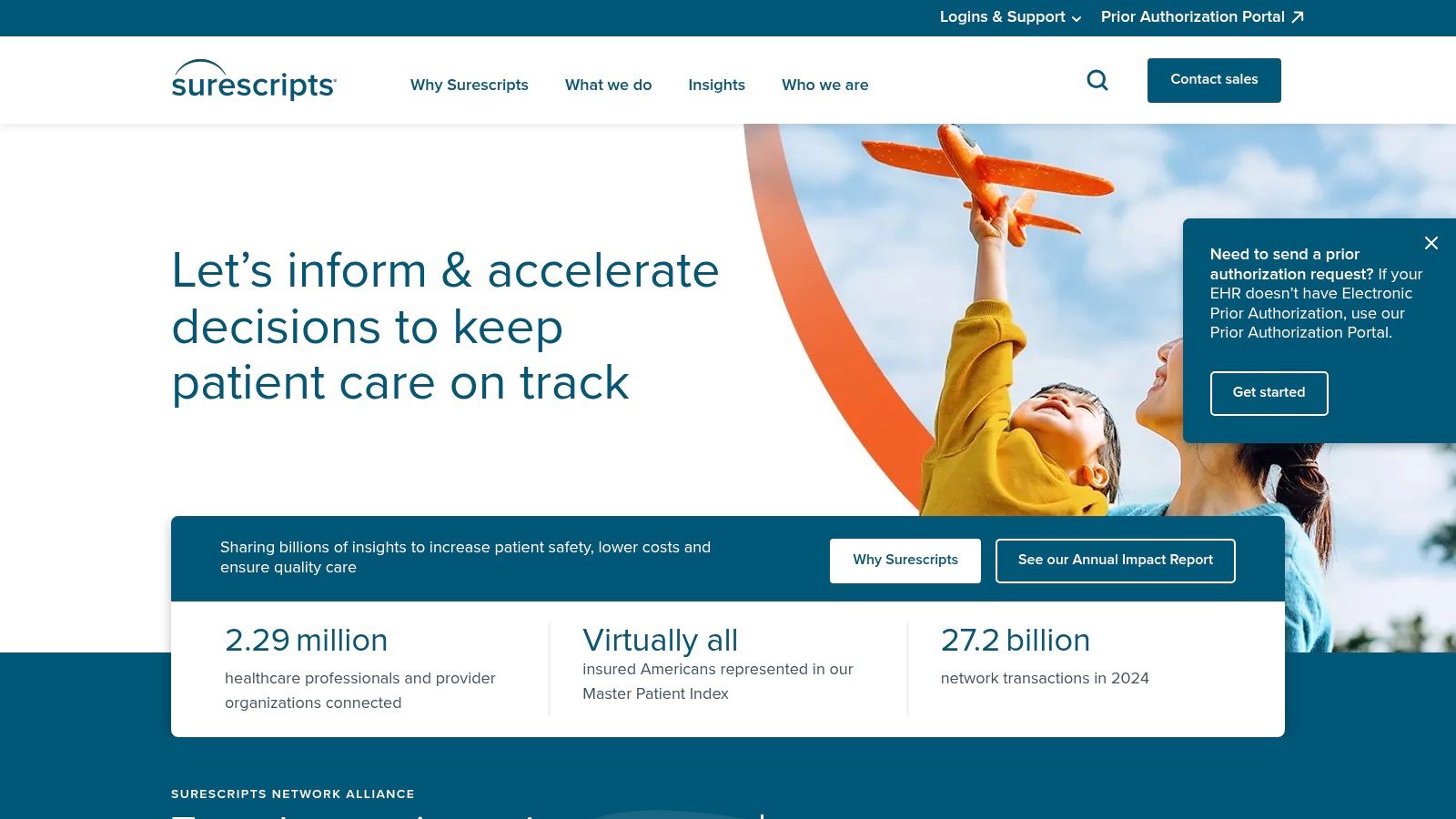
One of the key features of Surescripts is its real-time prescription benefit verification. Before prescribing a medication, physicians can quickly check a patient's insurance coverage and formulary information, including co-pays and potential out-of-pocket expenses. This real-time information empowers providers to make informed decisions at the point of care, selecting cost-effective medications that are covered by the patient's insurance plan. This transparency can significantly reduce prescription abandonment due to unexpected costs, improving patient adherence to prescribed therapies.
The electronic prior authorization submission feature further streamlines the prescription process. Instead of relying on fax machines and phone calls, providers can submit prior authorization requests electronically directly through the platform. This digital process reduces administrative burden, minimizes errors, and speeds up the approval process. This efficiency translates to faster access to necessary medications for patients and reduces the time spent by staff on manual prior authorization tasks. The system also offers alternative medication suggestions if the initially prescribed medication requires prior authorization or is not covered by the patient's insurance. This helps providers quickly identify suitable alternatives, minimizing treatment delays.
Surescripts integrates with major EHR and e-prescribing systems, creating a seamless workflow for healthcare professionals. This integration eliminates the need for separate logins and data entry, allowing providers to access prior authorization functionalities directly within their familiar systems. This streamlined approach saves time and improves efficiency.
While Surescripts offers significant benefits, it is important to consider its limitations. One notable drawback is its primary focus on prescription benefits rather than medical prior authorizations. If your practice frequently requires prior authorizations for medical procedures or tests, Surescripts may not be the most comprehensive solution. Additionally, the pricing structure may not be suitable for all practice sizes. Smaller practices might find the cost prohibitive, while larger organizations may benefit from the economies of scale. Implementing Surescripts can also be complex for smaller practices, requiring technical expertise and resources. Larger health systems, with dedicated IT staff, are typically better equipped to handle the implementation process.
Unfortunately, specific pricing and technical requirements for Surescripts Real-Time Prescription Benefit are not publicly available. Potential users should contact Surescripts directly for detailed pricing information and technical specifications tailored to their specific needs. Comparing Surescripts to similar prior authorization software solutions is crucial before making a decision. Consider factors like features, integration capabilities, and pricing to determine the best fit for your organization.
For practices considering implementing Surescripts, several tips can help ensure a smoother transition:
- Dedicated Project Team: Assemble a dedicated project team consisting of clinicians, IT staff, and administrative personnel to oversee the implementation process.
- Thorough Training: Ensure all staff members receive adequate training on using the software effectively within their workflows.
- Ongoing Support: Leverage Surescripts' support resources to address any technical issues or questions that may arise during and after implementation.
Surescripts earns its place on this list due to its comprehensive prescription benefit features, real-time information access, and electronic prior authorization capabilities. By streamlining the prescription process and improving patient access to medications, Surescripts offers substantial value to a wide range of healthcare providers. For more information, visit the Surescripts website: https://surescripts.com/
6. Trizetto Provider Solutions (Cognizant)
Trizetto Provider Solutions, a Cognizant offering, stands as a robust and comprehensive prior authorization software solution designed to streamline the often cumbersome process of obtaining approvals for medical procedures and services. This platform caters to a wide range of healthcare providers, from large hospital systems to smaller clinics, aiming to alleviate the administrative burden associated with prior authorizations and ultimately improve patient care. By automating key steps in the workflow, Trizetto helps free up valuable staff time, allowing them to focus on more critical tasks, while simultaneously accelerating the approval process for patients. This directly translates to improved patient satisfaction and potentially faster access to necessary treatments. Its inclusion in this list is warranted due to its comprehensive feature set, strong automation capabilities, and focus on integration within existing healthcare IT ecosystems.
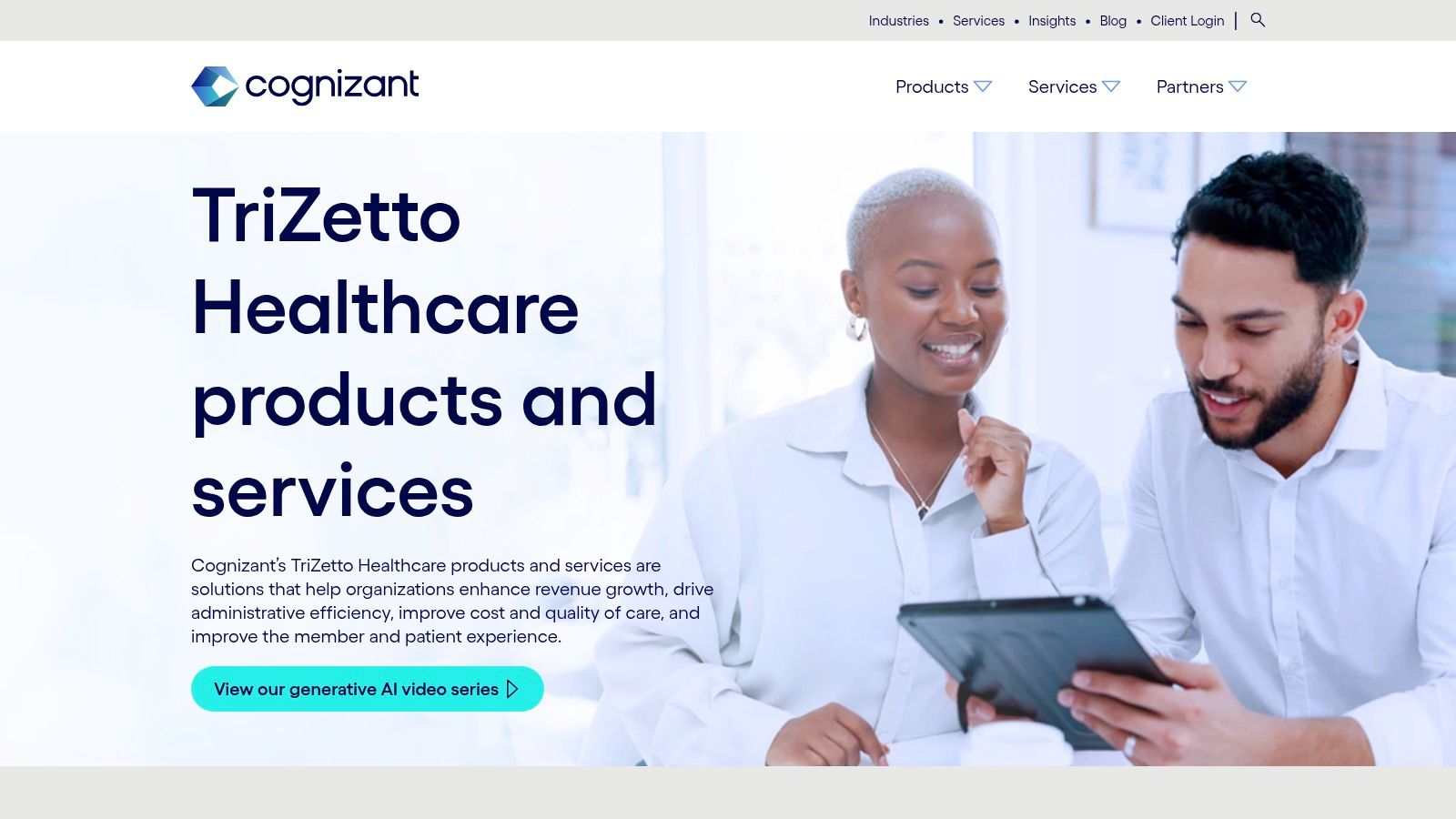
Trizetto Provider Solutions tackles the challenges of prior authorization through a multifaceted approach. Its intelligent routing capabilities ensure that authorization requests are directed to the correct payer on the first attempt, minimizing delays and rework. Automated submission of requests eliminates the need for manual data entry and faxing, reducing the risk of errors and freeing up staff. The platform also offers real-time tracking of authorization status, providing both providers and patients with up-to-date information on the progress of their requests. This transparency helps manage expectations and facilitates proactive communication. Furthermore, Trizetto boasts seamless integration with existing practice management (PM) and electronic health record (EHR) systems, ensuring a smooth flow of information and minimizing data silos. This integration is crucial for efficiency, allowing providers to initiate and manage prior authorizations directly within their familiar workflows.
A key strength of Trizetto lies in its robust reporting and analytics capabilities. Providers can gain valuable insights into authorization trends, payer performance, and areas for improvement within their own processes. These data-driven insights can be leveraged to optimize workflows, negotiate better contracts with payers, and ultimately improve revenue cycle management. The scalability of the solution also makes it a suitable choice for large healthcare organizations with complex needs.
While Trizetto offers a powerful suite of tools, it is important to consider its potential drawbacks. The platform's complexity and cost can be prohibitive for smaller practices with limited budgets. Implementation can also be a lengthy process, requiring significant upfront investment in time and resources. Some users have reported a steep learning curve, necessitating thorough training for staff to effectively utilize the system's full potential.
Unfortunately, specific pricing and technical requirements for Trizetto Provider Solutions are not readily available publicly. Interested parties are encouraged to contact Trizetto directly for a personalized quote and to discuss their specific needs. This personalized approach allows Trizetto to tailor solutions to individual practices, ensuring optimal configuration and integration.
Compared to other prior authorization software solutions, Trizetto's strengths lie in its comprehensive functionality, robust automation, and scalability. While some competitors might offer simpler, more affordable solutions for smaller practices, Trizetto excels in addressing the complex needs of larger organizations.
For practices considering implementing Trizetto Provider Solutions, it is crucial to plan meticulously. A dedicated project team should be established to oversee the implementation process, ensuring proper configuration, integration with existing systems, and comprehensive staff training. Engaging with Trizetto’s support team throughout the implementation phase is essential to address any challenges and maximize the platform's benefits. A phased rollout, starting with a pilot group, can help identify and address potential issues before full deployment.
In conclusion, Trizetto Provider Solutions (Cognizant) offers a powerful prior authorization software solution that can significantly streamline administrative processes, improve patient satisfaction, and optimize revenue cycle management. While its complexity and cost might make it less suitable for smaller practices, its comprehensive features and scalability make it a compelling choice for larger healthcare organizations seeking to effectively manage the complexities of prior authorizations. By automating key workflows and providing valuable data insights, Trizetto empowers providers to focus on what matters most – delivering high-quality patient care. Visiting their website (https://www.trizetto.com/) is recommended for a deeper dive into their offerings and to initiate contact for personalized solutions.
7. MedEvolve Practice Management
MedEvolve Practice Management stands out as a robust solution for medical practices seeking to streamline their prior authorization process. Unlike standalone prior authorization software, MedEvolve integrates this functionality directly within its comprehensive practice management platform. This integrated approach offers a distinct advantage by connecting prior authorizations with other crucial revenue cycle management (RCM) functions, creating a more efficient and profitable workflow for healthcare providers. This makes it a valuable tool for small to mid-sized medical practices, large healthcare systems and clinics, healthcare administrators, practice managers, physicians, clinical support staff, and even telemedicine and virtual care providers looking to optimize their operations and financial performance. It earns its place on this list by offering a comprehensive, integrated approach to prior authorization that goes beyond simply managing authorizations and delves into optimizing the entire revenue cycle.
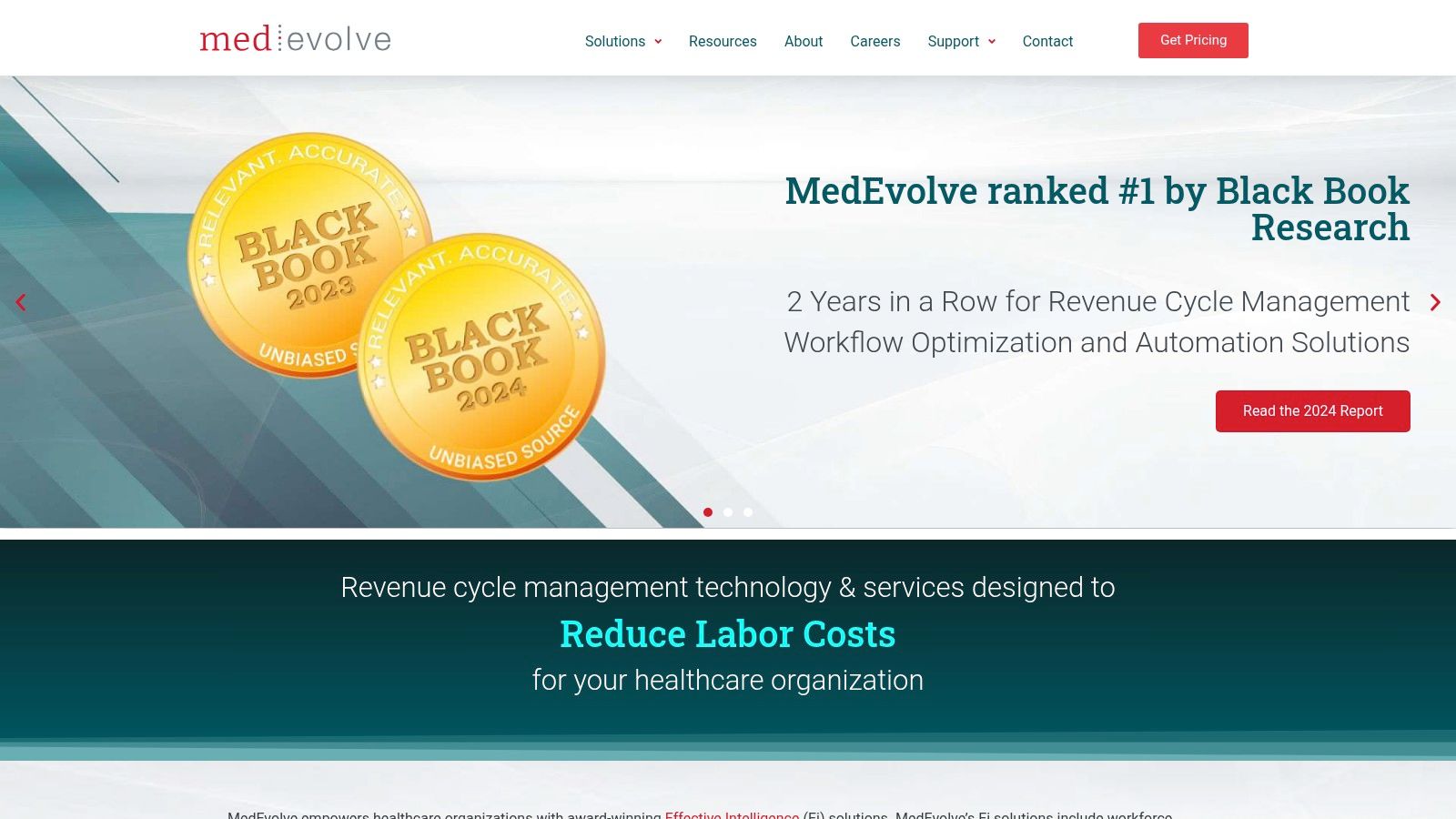
MedEvolve's prior authorization software tackles the often cumbersome and time-consuming process of obtaining approvals from insurance payers. Its automated prior authorization request generation feature significantly reduces manual data entry and paperwork, freeing up staff to focus on patient care and other essential tasks. The system automatically populates required fields with patient information pulled directly from the practice management system, minimizing errors and speeding up the submission process. Real-time eligibility and benefit verification further streamline the workflow, ensuring that claims are submitted with the correct information from the outset, thereby reducing the risk of denials.
A key strength of MedEvolve is its focus on revenue cycle optimization. By integrating prior authorization with billing workflows, the system ensures a seamless flow of information from pre-authorization to claim submission. This minimizes delays in payment processing and improves overall practice profitability. Customizable approval tracking and follow-up features allow staff to monitor the status of prior authorizations and proactively address any potential roadblocks. Automated reminders and alerts prevent authorizations from expiring and ensure timely follow-up, maximizing revenue capture. The integrated revenue cycle analytics and reporting tools provide valuable insights into practice performance, identifying areas for improvement and optimizing financial outcomes.
For example, consider a specialist practice dealing with complex procedures requiring prior authorization. MedEvolve can automate the creation of authorization requests, pulling patient demographics and procedure codes directly from the patient's chart. The system can then verify the patient's insurance benefits in real-time, ensuring that the requested procedure is covered and identifying any specific requirements. Once the authorization is submitted, staff can track its progress and receive automated alerts regarding any required actions, such as providing additional documentation. This automated workflow eliminates the need for manual tracking and follow-up, reducing administrative burden and preventing revenue loss due to denied claims.
While MedEvolve offers compelling advantages, there are some factors to consider. The platform is primarily designed for practices already using the MedEvolve Practice Management system. Implementing MedEvolve’s prior authorization solution might require significant workflow changes for practices transitioning from a different system. Furthermore, while the integrated approach is beneficial for existing MedEvolve users, practices seeking standalone prior authorization software may find the system less flexible. Unfortunately, pricing and specific technical requirements are not readily available on the website and would require contacting MedEvolve directly.
Implementation tips for practices transitioning to MedEvolve include dedicating sufficient time for staff training and system configuration. Working closely with MedEvolve's dedicated customer support team can facilitate a smooth transition and ensure that the system is tailored to the practice's specific needs. Mapping existing workflows and identifying areas for improvement before implementation can further optimize the integration process.
For practices already using MedEvolve Practice Management, integrating the prior authorization module offers a significant opportunity to streamline workflows and improve revenue cycle management. The automated features, real-time verification, and integrated reporting tools can significantly impact a practice's bottom line. For practices considering switching to MedEvolve, the integrated prior authorization solution provides a compelling reason to explore the platform's comprehensive capabilities. You can learn more by visiting their website: https://www.medevolve.com/
Prior Authorization Software Comparison
| Solution | Core Features / Automation ✨ | User Experience / Quality ★★★★☆ | Value Proposition / Pricing 💰 | Target Audience 👥 | Unique Selling Points 🏆✨ |
|---|---|---|---|---|---|
| 🏆 Simbie AI | Voice-based AI for intake, scheduling, Rx refills, auths | 24/7 availability, zero hold times, reduces burnout | Up to 60% admin cost reduction | Small to large healthcare practices | Clinically-trained AI, real-time call handling, HIPAA compliant |
| Waystar (formerly Zirmed) | Automated PA, real-time eligibility, EHR integration | Real-time status, reporting dashboard | Can be costly, enterprise focus | Medium to large healthcare providers | Strong EHR integrations, automated workflow |
| Allscripts Prior Authorization | EHR-native PA automation, real-time tracking | User-friendly for Allscripts users | Licensing fees apply | Allscripts EHR users | Seamless Allscripts ecosystem integration |
| CoverMyMeds | E-prescription PA, extensive payer network | Mobile app, strong support | Free basic tier, paid premium features | Pharmacies & prescribers | Largest payer network, pharmacy-focused |
| Surescripts Real-Time Rx Benefit | Rx benefits, PA submission, formulary lookup | Real-time prescribing info | Pricing varies, focus on Rx benefits | Prescribers and healthcare providers | Real-time benefits, alternative med suggestions |
| Trizetto Provider Solutions | Automated PA routing & tracking, analytics | Scalable, robust reporting | Expensive, complex setup | Large providers & health systems | Intelligent routing, deep analytics |
| MedEvolve Practice Management | PA + revenue cycle management automation | Integrated financial insights | PM system dependent, workflow changes needed | MedEvolve users | Combines PA with revenue cycle management |
Choosing the Right Prior Authorization Software
Selecting the right prior authorization software can significantly impact your practice's efficiency and bottom line. From simplifying complex workflows to reducing the administrative burden on your staff, the right tool can free up valuable time and resources. We've explored seven leading prior authorization software platforms in this article: Simbie AI, Waystar, Allscripts, CoverMyMeds, Surescripts, Trizetto, and MedEvolve. Each offers unique features and caters to different needs and budgets.
Key takeaways when choosing your prior authorization software include evaluating your current EHR integrations, considering your practice size and specialty, and defining your budget constraints. Implementing these tools effectively requires staff training and ongoing optimization to maximize their potential. Remember to look for features that streamline your specific workflows, such as automated submissions, real-time benefit checks, and robust reporting capabilities.
Ultimately, the best prior authorization software will empower your practice to reduce denials, improve patient satisfaction, and focus on what matters most – delivering quality care.
Ready to experience the future of prior authorization? Simbie AI offers cutting-edge, AI-powered solutions to automate and simplify the prior authorization process. Learn more and request a demo at Simbie AI.

